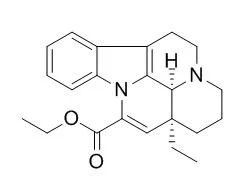| Animal Research: |
| Exp Eye Res. 2014 Oct;127:49-58. | | Vinpocetine inhibits amyloid-beta induced activation of NF-κB, NLRP3 inflammasome and cytokine production in retinal pigment epithelial cells.[Pubmed: 25041941] | Chronic inflammation is a key pathogenic process in age-related macular degeneration (AMD). Amyloid-beta (Aβ) is a constituent of AMD drusen and promotes the activation of NLRP3 inflammasome which facilitates the production of cytokines.
METHODS AND RESULTS:
We investigated the role of transcription factor NF-κB in the activation of inflammasome in the RPE and the effect of Vinpocetine, a dietary supplement with inhibitory effect on NF-κΒ. ARPE19/NF-κB-luciferase reporter cells treated with Aβ demonstrated enhanced NF-κB activation that was significantly suppressed by Vinpocetine. Intraperitoneal injection of Vinpocetine (15 mg/kg) inhibited NF-κB nuclear translocation and reduced the expression and activation of NLRP3, caspase-1, IL-1β, IL-18, and TNF-α in the RPE of adult rats that received intraocular Αβ, as measured by retinal immunohistochemistry and Western blot. Cytokine level in the vitreous was assayed using multiplex suspension arrays and revealed significantly lower concentration of MIP-3α, IL-6, IL-1α, IL-1β, IL-18, and TNF-α in Vinpocetine treated animals. These results suggest that the NF-κB pathway is activated by Aβ in the RPE and signals the priming of NLRP3 inflammasome and the expression of pro-inflammatory cytokines including the inflammasome substrates IL-1β and IL-18. NF-κB inhibition may be an effective approach to stem the chronic inflammatory milieu that underlies the development of AMD.
CONCLUSIONS:
Vinpocetine is a potentially useful anti-inflammatory agent that is well-tolerated in long term use. | | Chem Biol Interact. 2015 Jul 25;237:9-17. | | Vinpocetine reduces lipopolysaccharide-induced inflammatory pain and neutrophil recruitment in mice by targeting oxidative stress, cytokines and NF-κB.[Pubmed: 25980587] | In response to lipopolysaccharide (LPS), tissue resident macrophages and recruited neutrophils produce inflammatory mediators through activation of Toll-like receptor 4 (TLR4)/nuclear factor kappa B (NF-κB) signaling pathway. These mediators include inflammatory cytokines and reactive oxygen species that, in turn, sensitize nociceptors and lead to inflammatory pain. Vinpocetine is a nootropic drug widely used to treat cognitive and neurovascular disorders, and more recently its anti-inflammatory properties through inhibition of NF-κB activation have been described.
METHODS AND RESULTS:
In the present study, we used the intraplantar and intraperitoneal LPS stimulus in mice to investigate the effects of Vinpocetine pre-treatment (3, 10, or 30mg/kg by gavage) in hyperalgesia, leukocyte recruitment, oxidative stress, and pro-inflammatory cytokine production (TNF-α, IL-1β, and IL-33). LPS-induced NF-κB activation and cytokine production were investigated using RAW 264.7 macrophage cell in vitro. Vinpocetine (30mg/kg) significantly reduces hyperalgesia to mechanical and thermal stimuli, and myeloperoxidase (MPO) activity (a neutrophil marker) in the plantar paw skin, and also inhibits neutrophil and mononuclear cell recruitment, superoxide anion and nitric oxide production, oxidative stress, and cytokine production (TNF-α, IL-1β and IL-33) in the peritoneal cavity. At least in part, these effects seem to be mediated by direct effects of Vinpocetine on macrophages, since it inhibited the production of the same cytokines (TNF-α, IL-1β and IL-33) and the NF-κB activation in LPS-stimulated RAW 264.7 macrophages.
CONCLUSIONS:
Our results suggest that Vinpocetine represents an important therapeutic approach to treat inflammation and pain induced by a gram-negative bacterial component by targeting NF-κB activation and NF-κB-related cytokine production in macrophages. |
|






 Cell. 2018 Jan 11;172(1-2):249-261.e12. doi: 10.1016/j.cell.2017.12.019.IF=36.216(2019)
Cell. 2018 Jan 11;172(1-2):249-261.e12. doi: 10.1016/j.cell.2017.12.019.IF=36.216(2019) Cell Metab. 2020 Mar 3;31(3):534-548.e5. doi: 10.1016/j.cmet.2020.01.002.IF=22.415(2019)
Cell Metab. 2020 Mar 3;31(3):534-548.e5. doi: 10.1016/j.cmet.2020.01.002.IF=22.415(2019) Mol Cell. 2017 Nov 16;68(4):673-685.e6. doi: 10.1016/j.molcel.2017.10.022.IF=14.548(2019)
Mol Cell. 2017 Nov 16;68(4):673-685.e6. doi: 10.1016/j.molcel.2017.10.022.IF=14.548(2019)